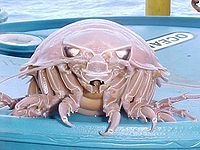- Deep-sea gigantism
-
In zoology, deep-sea gigantism, also known as abyssal gigantism, is the tendency for species of crustaceans, invertebrates and other deep-sea-dwelling animals to display a larger size than their shallow-water counterparts. Examples of this phenomenon include the giant isopod, the Japanese spider crab, the king of herrings (an oarfish of up to 12 m), the Seven-arm Octopus, and a number of squid species: the Colossal Squid (up to 14 m in length), the giant squid (up to 13 m), the Robust Clubhook Squid, the Dana Octopus Squid, Galiteuthis phyllura, Kondakovia longimana, and the bigfin squids.
It is not known whether this effect comes about as a result of adaptation for scarcer food resources (therefore delaying sexual maturity and resulting in greater size), greater pressure, or for other reasons. The Blue Planet series posited that larger specimens do well in the abyssal environment due to advantages in body temperature regulation and a diminished need for constant activity, both inherent in organisms with a lower surface area to mass ratio.
One example for which scientists do have an explanation is the giant tube worm. These creatures live off hydrothermal vents, which supply them with enormous amounts of energy.
See also
External links
Categories:- Aquatic organisms
- Oceanography stubs
Wikimedia Foundation. 2010.

